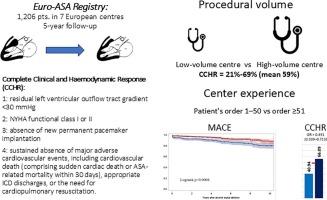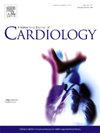Impact of centre experience on complete clinical and haemodynamic response after alcohol septal ablation for hypertrophic obstructive cardiomyopathy
IF 3.2
2区 医学
Q2 CARDIAC & CARDIOVASCULAR SYSTEMS
引用次数: 0
Abstract
Background
Alcohol septal ablation (ASA) is an established therapy for symptomatic hypertrophic obstructive cardiomyopathy (HOCM) in patients unresponsive to medical treatment. However, comprehensive assessment of ASA outcomes remains challenging. This study aimed to evaluate the impact of institutional experience and patient characteristics on achieving complete clinical and haemodynamic response (CCHR), a novel composite outcome integrating long-term symptomatic, haemodynamic, safety, and major clinical endpoints, including survival and resuscitation.
Methods
We retrospectively analysed 1206 symptomatic HOCM patients undergoing first-time ASA between 1996 and 2023 in seven European centres. CCHR was defined as residual left ventricular outflow tract (LVOT) gradient <30 mmHg, NYHA class I/II, absence of new permanent pacemaker implantation, and absence of major adverse cardiovascular events at last follow-up.
Results
After a median follow-up of 4.9 (IQR 2.0–7.0) years, CCHR was achieved in 59 % of patients, with inter-centre variability ranging from 21.4 % to 69.3 %. Centres with higher procedural volumes showed significantly better outcomes. Patients treated within the first 50 procedures at a centre had significantly lower odds of achieving CCHR (OR 0.49; 95 % CI 0.34–0.71; p < 0.001). Younger age, lower baseline LVOT gradient, and higher baseline ejection fraction were independent predictors of success.
Conclusions
CCHR, integrating both haemodynamic and hard clinical outcomes, was achieved in the majority of ASA-treated HOCM patients. Institutional experience and patient selection emerged as key determinants of success. These findings support centralisation of ASA in high-volume centres and may inform patient-tailored therapeutic strategies.

中心经验对酒精性室间隔消融治疗肥厚性阻塞性心肌病后完全临床和血流动力学反应的影响
背景:酒精室间隔消融术(ASA)是治疗对药物治疗无反应的症状性肥厚性阻塞性心肌病(HOCM)的常用治疗方法。然而,ASA结果的综合评估仍然具有挑战性。本研究旨在评估机构经验和患者特征对实现完全临床和血流动力学反应(CCHR)的影响,CCHR是一种综合了长期症状、血流动力学、安全性和主要临床终点(包括生存和复苏)的新型复合结局。方法:我们回顾性分析了1996年至2023年间在欧洲7个中心首次接受ASA治疗的1206例有症状的HOCM患者。CCHR被定义为左心室流出道(LVOT)梯度残留。结果:中位随访4.9年(IQR 2.0-7.0)后,59% %的患者实现了CCHR,中心间变异范围为21.4% %至69.3% %。手术量较高的中心表现出明显更好的结果。在一个中心接受前50次手术的患者实现CCHR的几率明显较低(OR 0.49; 95 % CI 0.34-0.71; p )结论:大多数接受asa治疗的HOCM患者实现了CCHR,综合了血流动力学和硬临床结果。机构经验和患者选择成为成功的关键决定因素。这些发现支持ASA在大容量中心的集中,并可能为患者量身定制的治疗策略提供信息。
本文章由计算机程序翻译,如有差异,请以英文原文为准。
求助全文
约1分钟内获得全文
求助全文
来源期刊

International journal of cardiology
医学-心血管系统
CiteScore
6.80
自引率
5.70%
发文量
758
审稿时长
44 days
期刊介绍:
The International Journal of Cardiology is devoted to cardiology in the broadest sense. Both basic research and clinical papers can be submitted. The journal serves the interest of both practicing clinicians and researchers.
In addition to original papers, we are launching a range of new manuscript types, including Consensus and Position Papers, Systematic Reviews, Meta-analyses, and Short communications. Case reports are no longer acceptable. Controversial techniques, issues on health policy and social medicine are discussed and serve as useful tools for encouraging debate.
 求助内容:
求助内容: 应助结果提醒方式:
应助结果提醒方式:


